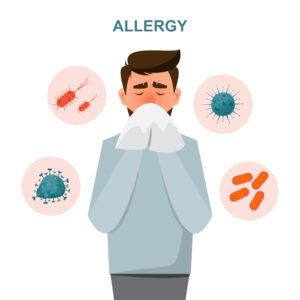Allergy And Immunotherapy

Allergic rhinitis and sinusitis is a IgE mediated hypersensitivity disease which involves the mucous membrane of the nose and paranasal sinuses and is clinically characterized by sneezing, itching in the nose and eyes, watery nasal discharge and a sensation of nasal obstruction.
Allergic rhinitis can be either seasonal or perennial. Although the disease is commonly overlooked but this causes a lot of morbidity, social embrassement and impaired performance at school or workplace. The disease is extremely common and prevalence depends upon the age, gender and geographical location of the population.
Aetiology
- Atopy- genetically inherited, autosomal dominant with strong maternal influence
- Allergens –
- seasonal rhinitis- most commonly due to glass pollen, tree pollens, weed pollens and fungal spores
- perennial allergic rhinitis- commonest cause is house dust mites found in pillows, bed clothes, curtains,carpets, soft furnishing, domestic pets, cockroach
- Occupational allergens – flour, wood dust,washing powders,latex, chemical paints , platinum salts, drugs
- Food and drug induced rhinitis
Histamine containing foods such as fish, cheese,wines ,milk, eggs,nuts,shellfish, citrus foods
Aspirin induced hypersensitivity
Antihypertensive drugs
Rhinitis medicamentosa - Role of pollution- tobacco smoke,traffic fumes, domestic sprays,perfumes, bleaching agents
Diagnosis
- Skin prick tests
- RAST- radio allergosorbent test
- Serum Ig E tests
- Nasal cytology
Skin prick tests
It is an inexpensive, accurate, rapid test that can be undertaken with a wide variety of allergens. They are now preferred over the intradermal or scratch tests which are less reproducible, dangerous and may give false positive tests. A large of allergens including environmental, food allergens, house dust mites and other allergens which may be geographically appropriate may be utilized while performing the test.
Management
- Allergen avoidance
- Pharmacotherapy- steroids, antihistaminics, topical vasoconstrictors, topical corticosteroids
- Immunotherapy – This treatment can be really instrumental in relieving the symptoms in patients with allergic rhinitis. This treatment has the potential to alter the course of the disease as compared to the conventional pharmacotherapy
Immunotherapy is broadly of two types- sublingual and
Indications for immunotherapy
- Evidence of Ig E mediated disease in which allergens are considered to the major triggers
- Inability to avoid allergens
- Inadequacy of drug therapy or intolerable side effects of such therapy
- Limited spectrum of allergen sensitivities
- Compliance
Contraindications
- Non availability of suitable allergen extracts
- Significant medical or immunological disease
- Multiple allergies
- Drugs which might interfere with treatment for anaphylaxis(beta- blockers)

